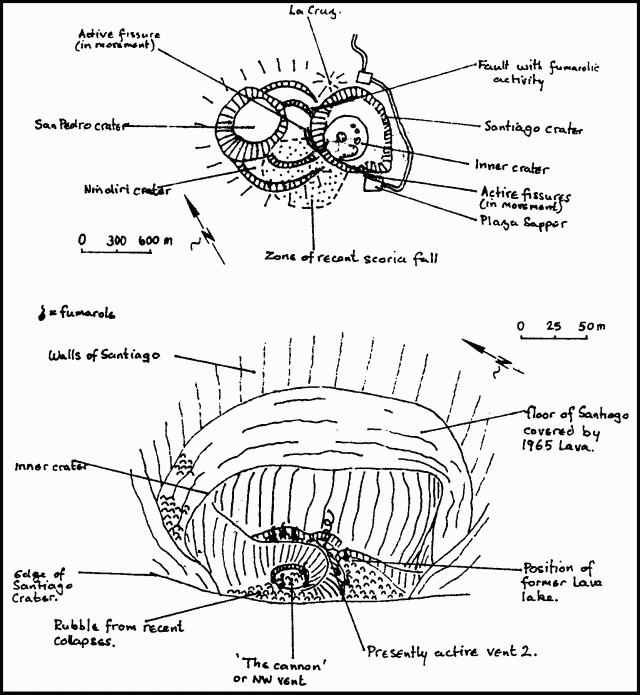Report on Masaya (Nicaragua) — June 1989
Scientific Event Alert Network Bulletin, vol. 14, no. 6 (June 1989)
Managing Editor: Lindsay McClelland.
Masaya (Nicaragua) Lava lake freezes; small explosions
Please cite this report as:
Global Volcanism Program, 1989. Report on Masaya (Nicaragua) (McClelland, L., ed.). Scientific Event Alert Network Bulletin, 14:6. Smithsonian Institution. https://doi.org/10.5479/si.GVP.SEAN198906-344100
Masaya
Nicaragua
11.9844°N, 86.1688°W; summit elev. 594 m
All times are local (unless otherwise noted)
The February-March lava lake in Santiago Crater (14:02) probably froze over in early March, and degassing from the lake vent had apparently ceased by 12 March. Other vents remained open through April, with occasional strong degassing episodes. Beginning around 11 May, collapses from the W, S, and N sides of the main crater blocked all vents. Little, if any, gas emission was evident until 22 May when park rangers reported more collapses and a plume visible from the Masaya road (6 km from the crater).
On 25 May, geologists found fresh scoria and lithic fragments scattered from Plaza Sapper to the San Pedro crater (figure 7, top). Ten-cm fragments were found to 20 m from the edge of Santiago, 5-cm fragments to 50 m, and fragments <2 cm were found farther away (90% <1 cm). All tephra was highly vesicular, often with smooth surfaces indicating solidification in flight. Many Pelé's tears were found. The fragments were concentrated in small areas, suggesting a number of discrete explosions. Tephra from the explosions rose an estimated 100-300 m above the crater. Most fragments were glassy basalt with occasional small (1-3 mm) fresh plagioclase. Lithic fragments were porphyritic basalts with 10% plagioclase and some were slightly altered hydrothermally.
 |
Figure 7. Sketch of the summit complex at Masaya, May-June 1989 (top) and Santiago Crater, 3 June 1989 (bottom). Courtesy of B. van Wyk de Vries and O. Castellón. |
A 3 June visit revealed small amounts of fresh scoria up to 5 cm in diameter as far as 50 m SW of the crater. The tephra was probably erupted on 2 June when inhabitants reported a "brown cloud". Crater geometry was similar to that in February. The lava lake vent and the "cannon" (3rd vent in 14:02) were blocked by collapse debris, but vent No. 2 (glowing vent in 14:02) had enlarged and was thought to be the source of the eruptions. On 25 May the vent was oval and about 4 m across, oriented vertically, rather than horizontally as in February. On the 26th it had enlarged by 1 m, and by 3 June it was 7 x 3 m and rectangular. There appeared to be a considerably larger chamber beneath the vent. The cannon (3rd) deepened slightly between 25 May and 3 June.
Periodic fumarolic activity on the W wall and from a fault on the N side (figure 7, bottom) was also observed. Weak fumaroles along the trend of the fault (on the Nindirí crater floor below La Cruz) had temperatures <45°C. Fumarolic activity decreased from May to June.
Geological Summary. Masaya volcano in Nicaragua has erupted frequently since the time of the Spanish Conquistadors, when an active lava lake prompted attempts to extract the volcano's molten "gold" until it was found to be basalt rock upon cooling. It lies within the massive Pleistocene Las Sierras caldera and is itself a broad, 6 x 11 km basaltic caldera with steep-sided walls up to 300 m high. The caldera is filled on its NW end by more than a dozen vents that erupted along a circular, 4-km-diameter fracture system. The Nindirí and Masaya cones, the source of observed eruptions, were constructed at the southern end of the fracture system and contain multiple summit craters, including the currently active Santiago crater. A major basaltic Plinian tephra erupted from Masaya about 6,500 years ago. Recent lava flows cover much of the caldera floor and there is a lake at the far eastern end. A lava flow from the 1670 eruption overtopped the north caldera rim. Periods of long-term vigorous gas emission at roughly quarter-century intervals have caused health hazards and crop damage.
Information Contacts: B. van Wyk de Vries and O. Castellón, INETER.

